UPSC Daily Current Affairs- January 24, 2022 | Current Affairs: Daily, Weekly & Monthly - CLAT PDF Download
GS-I
UNESCO tag sought for Living Root Bridges of Meghalaya
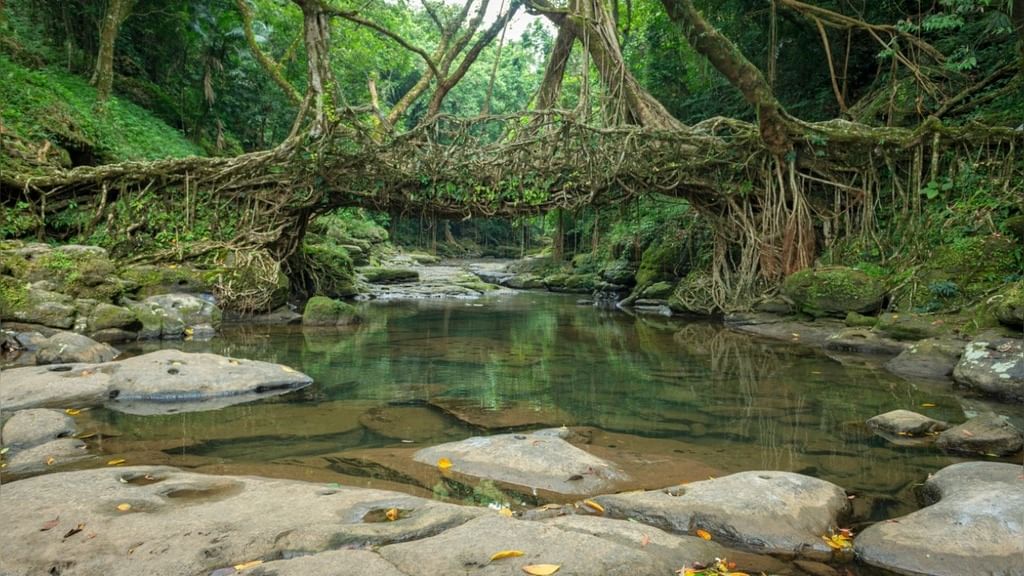
Context
The Zoological Survey of India (ZSI) has underlined some green rules for the living root bridges of Meghalaya to get the UNESCO World Heritage Site tag.
About Living Root Bridges
- A living root bridge is a type of simple suspension bridge formed of living plant roots by tree shaping.
- They are common in the southern part of the Northeast Indian state of Meghalaya. Such a bridge is locally called jingkieng jri.
- They are handmade from the aerial roots of rubber fig trees (Ficus elastic) by the Khasi and Jaintia peoples of the mountainous terrain along the southern part of the Shillong Plateau.
- Most of the bridges grow on steep slopes of subtropical moist broadleaf forest between 50m and 1150m above sea level.
Why is it so unique?
- As long as the tree from which it is formed remains healthy, the roots in the bridge can naturally grow thick and strengthen.
- New roots can grow throughout the tree’s life and must be pruned or manipulated to strengthen the bridge.
- Once mature some bridges can have as many as 50 or more people crossing, and have a lifespan of up to 150 years.
Who was Sri Ramanuja?

Context
Work is going apace on the 216-ft tall ‘Statue of Equality’ of the 11th century reformer and Vaishnavite saint, Sri Ramanuja, to be unveiled by PM Modi next month in Hyderabad.
About Statue of Equality
- The ‘Statue of Equality’, as it is called, is being installed to mark the 1,000th birth anniversary of Sri Ramanuja.
- It was built of panchaloha, a combination of gold, silver, copper, brass and zinc, by the Aerospun Corporation in China and shipped to India.
- It is the second-largest in the world in sitting position of the saint.
- The monument will be surrounded by 108 “Divya Desams” of Sri Vaishnavite tradition (model temples) like Tirumala, Srirangam, Kanchi, Ahobhilam, Badrinath, Muktinath, Ayodhya, Brindavan, Kumbakonam and others. The idols of deities and structures were constructed in the shape at the existing temples.
About Sri Ramanuja
- Ramanuja or Ramanujacharya (1017–1137 CE) was a philosopher, Hindu theologian, social reformer, and one of the most important exponents of Sri Vaishnavism tradition within Hinduism.
- His philosophical foundations for devotionalism were influential to the Bhakti movement.
About his Works
- Ramanuja’s philosophical foundation was qualified monism and is called Vishishtadvaita in the Hindu tradition.
- His ideas are one of three subschools in Vedanta, the other two are known as Adi Shankara’s Advaita (absolute monism) and Madhvacharya’s Dvaita (dualism)
- Important writings include:
- Vedarthasangraha (literally, “Summary of the Vedas meaning”),
- Sri Bhashya (a review and commentary on the Brahma Sutras),
- Bhagavad Gita Bhashya (a review and commentary on the Bhagavad Gita), and
- The minor works titled Vedantapida, Vedantasara, Gadya Trayam (which is a compilation of three texts called the Saranagati Gadyam, Sriranga Gadyam and the Srivaikunta Gadyam), and Nitya Grantham.
GS-II
Consent of AG to initiate contempt proceedings
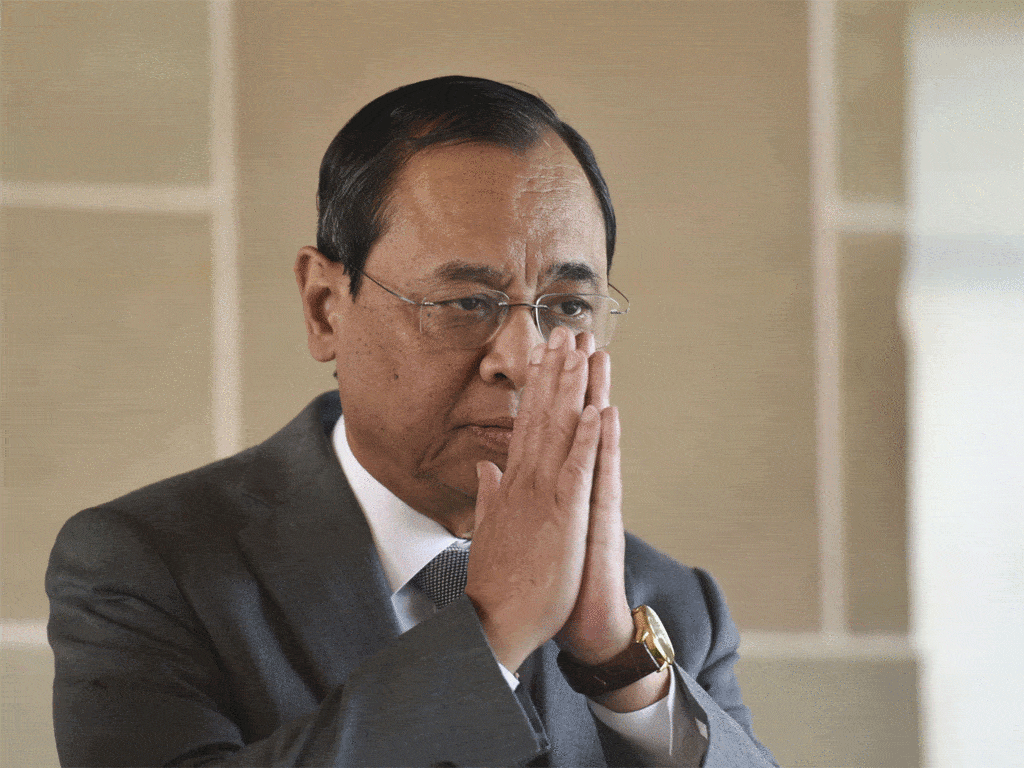
Context
Attorney General K K Venugopal has granted consent to initiate contempt proceedings against ‘Dharam Sansad’ leader Yati Narsinghanand over his alleged remarks against the Constitution and the Supreme Court.
Need for consent
As per Section 15 of the Contempt of Courts Act, the nod of the Attorney General or the Solicitor General is a condition precedent to set the criminal contempt proceedings in motion before the apex court.
What is the law on contempt of courts?
The Contempt of Courts Act 1971 defines civil and criminal contempt, and lays down the powers and procedures by which courts can penalise contempt, as well as the penalties that can be given for the offence of contempt.
- Contempt of court is the offense of being disobedient to or disrespectful toward a court of law and its officers in the form of behavior that opposes or defies the authority, justice and dignity of the court.
Why is the consent of the Attorney General required to initiate contempt proceedings?
The objective behind requiring the consent of the Attorney General before taking cognizance of a complaint is to save the time of the court.
- This is necessary because judicial time is squandered if frivolous petitions are made and the court is the first forum for bringing them in.
- The AG’s consent is meant to be a safeguard against frivolous petitions, as it is deemed that the AG, as an officer of the court, will independently ascertain whether the complaint is indeed valid.
Under what circumstances is the AG’s consent not needed?
The AG’s consent is mandatory when a private citizen wants to initiate a case of contempt of court against a person. However, when the court itself initiates a contempt of court case the AG’s consent is not required.
- This is because the court is exercising its inherent powers under the Constitution to punish for contempt and such Constitutional powers cannot be restricted because the AG declined to grant consent.
What happens if the AG denies consent?
If the AG denies consent, the matter all but ends. The complainant can, however, separately bring the issue to the notice of the court and urge the court to take suo motu cognizance.
- Article 129 of the Constitution gives the Supreme Court the power to initiate contempt cases on its own, independent of the motion brought before it by the AG or with the consent of the AG.
Is suspension of MLAs up for Judicial Review?
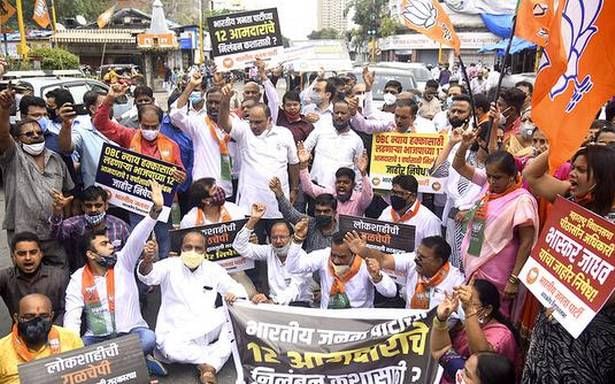
Context
- Some legislators were suspended for one year by the Maharashtra Assembly for alleged disorderly conduct.
- The unusually long period of suspension has been questioned by the Supreme Court, which is hearing a challenge to the Assembly’s action.
A case in apex court
- The court has reserved its judgment after hearing elaborate arguments.
- The main question before the court is whether suspension for a whole year is valid.
Suspending MLAs: A fact check
- Each state has their individual rules for the conduct of assembly. These rules provides for the suspension of MLAs.
- Under Rule 53 of the Maharashtra Legislative Assembly Rules, 1960, only the Speaker has the power to suspend MLAs indulging in unruly behavior.
- Therefore, the motion to suspend cannot be put to vote as this would allow the Government to suspend as many Members of Opposition as it sees fit.
Constitutional ground behind this suspension
- The Court referred to Article 190 (4) of the Constitution which says that if for a period of 60 days, a member of a House, without its permission, is absent; the House may declare his or her seat vacant.
- Suspension of MLAs beyond this period would lead to their disqualification.
What did the Supreme Court observe?
- Suspension of the MLAs would amount to punishing the constituencies as a whole.
- Each constituency has equal amount of right to be represented in the House, observed the court.
- The apex court observed that any state cannot create a constitutional void, a hiatus situation for any constituency.
- It said the House cannot suspend a member beyond 59 days.
What does the State government say?
- Counsel for the State government has argued that there is no limitation on the power of the legislature to punish for breach of privilege or disorderly conduct in the course of its proceedings.
- Once the power to punish a member for disorderly conduct is recognized, there can be no judicial review of the manner in which it is exercised.
- Further, during suspension, a member continues to hold office, but only loses their voice in the legislature.
District Good Governance Index (DGGI)
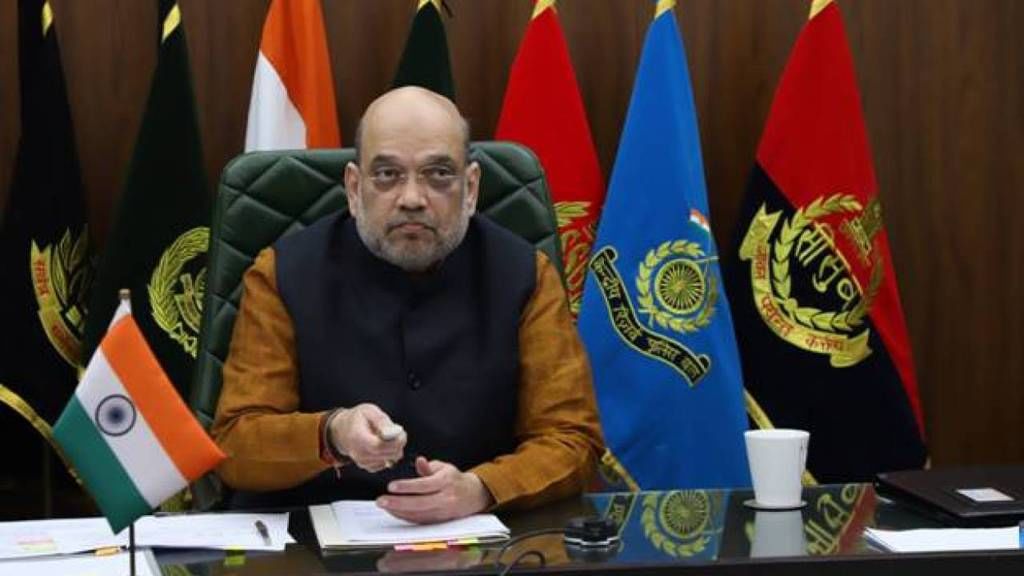
Context
Union home minister Amit Shah recently launched the District Good Governance Index (DGGI) in Jammu and Kashmir, which is the first Union Territory to have such an index.
About the index
- Launched for 20 districts of Jammu and Kashmir.
- It has been prepared by the Department of Administrative Reforms and Public Grievances (DARPG) in partnership with the Union Territory’s administration.
- Under the index, the policies, schemes and programs of the central as well as the state governments have been monitored at the district level.
Significance of the index
- The beginning of this index in Jammu and Kashmir will slowly expand to all other states and a good governance competition will start in every district of the country.
- The index covered 10 sectors and 58 indicators.
- The index will benefit residents of Jammu and Kashmir in a big way as it will work towards improving the district machinery, make districts result-oriented and also improve their delivery mechanism.
Highlights of the index
- Jammu district topped the composite ranking, followed by Doda and Samba districts of the Jammu Division.
- This was followed by Pulwama district of the Srinagar Division at fourth spot and Srinagar district at the fifth.
- The district of Rajouri finished at the last spot, while Poonch and Shopian districts also featured towards the end of the rankings.
- Srinagar district bagged the first rank in Public Infrastructure and Utilities sector.
- Srinagar also ranked in the top 5 districts in Composite GGI in Kashmir Division with a score of 5.313 points.
- Kishtwar topped in ‘Agriculture and Allied Sector’, Pulwama topped in ‘Human Resource Development’, Reasi topped in ‘Public Health’, Ramban topped in ‘Social Welfare and Development’, and Ganderbal topped in the ‘Financial Inclusion’ sector.
Performance of J&K in the National Good Governance Index
- Previously, the Centre had released the National Good Governance Index on December 25 last year that indicated Jammu and Kashmir saw an increase of 3.7% in Good Governance Indicators from 2019 to 2021.
- The strong performance of J-K was also noted in the fields of commerce and industry, agriculture, judiciary and public infrastructure among others.
GS-III
Kerala gets its first-ever Scientific Bird Atlas
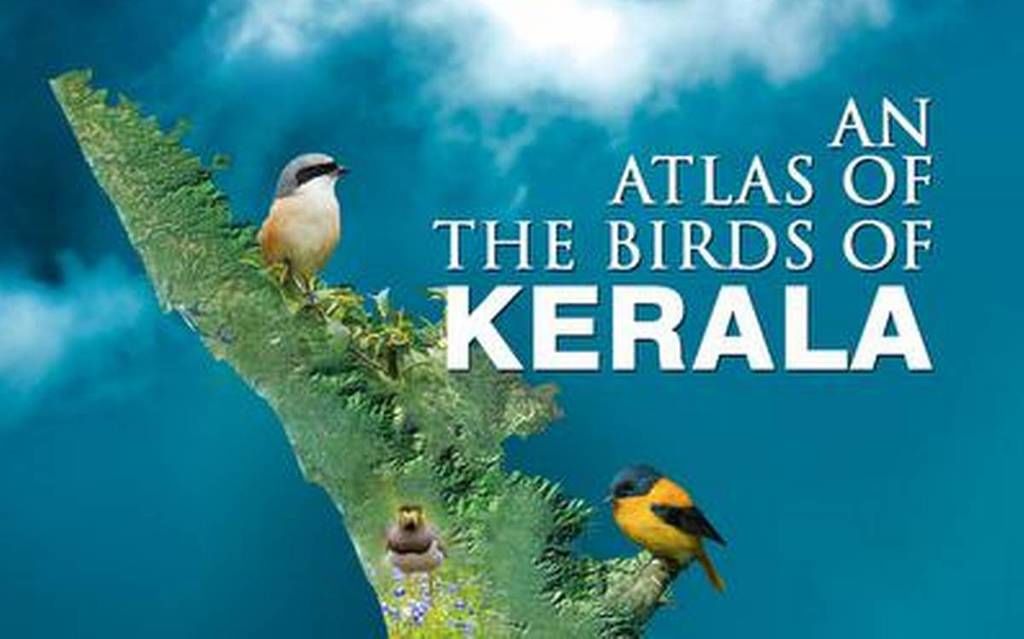
Context
The Kerala Bird Atlas (KBA), the first-of-its-kind State-level bird atlas in India, has created solid baseline data about the distribution and abundance of bird species across all major habitats, giving an impetus to futuristic studies.
About Kerala Bird Atlas (KBA)
- The KBA has been prepared based on systematic surveys held twice over 60 days a year during the wet (July to September) and dry (January to March) seasons between 2015 and 2020.
- It was conducted as a citizen science-driven exercise with the participation of over 1,000 volunteers of the birdwatching community.
- The KBA accounts for nearly three lakh records of 361 species, including 94 very rare species, 103 rare species, 110 common species, 44 very common species, and 10 most abundant species.
- It was found that the species count was higher during the dry season than in the wet season while species richness and evenness were higher in the northern and central districts than in the southern districts.
Significance of KBA
- The KBA offers authentic, consistent and comparable data through random sampling from the geographical terrain split.
- It is arguably Asia’s largest bird atlas in terms of geographical extent, sampling effort and species coverage derived from the aggregation of 25,000 checklists.
- The KBA is considered to be a valuable resource for testing various ecological hypotheses and suggesting science-backed conservation measures.
A chance to support growth, fiscal consolidation

Context
The adverse effect of the third wave of COVID-19, which is mainly affecting the last quarter of 2021-22, may call for a further downward adjustment in the growth rate to about 9%.
Growth in FY 2021-22
- As per the NSO’s advance estimates, at the end of 2021-22, the magnitude of GDP in real terms is estimated at INR₹147.5-lakh crore that is only a shade higher than INR₹145.7-lakh crore in 2019-20.
- Thus, due to the three waves of COVID-19 that India has experienced, two years of real growth in economic activities have been wiped out.
- As per the advance estimates, the gross fixed capital formation (GFCF) relative to GDP at current prices stands at 29.6% in 2021-22.
- Capacity utilisation in India continues to have considerable slack. Private final consumption expenditure (PFCE) also shows a low growth of 6.9% in 2021-22.
- Any pick-up in demand would continue to be constrained by low-income growth in sectors characterised by a high marginal propensity to consume (MPC) such as the trade, transport, et al. sector and the Micro, Small and Medium Enterprise (MSME) sector more broadly.
- It may thus be prudent to expect a real GDP growth in the range of 6%-7%.
- Growth in 2022-23 would also continue to be constrained by supply-side bottlenecks and high prices of global crude and primary products.
- Growth in 2022-23 would depend on the basic determinants such as the saving and investment rates in the economy.
Suggestions
- Extend GST compensation period: The GST compensation provision would also come to an end in June 2022.
- This would cause a major revenue shock at least for some States such as Tamil Nadu, Kerala and Andhra Pradesh.
- While this matter may be considered by the GST Council, the compensation arrangement should be extended by two years in some modified form.
- With respect to non-tax receipts, the scope of the National Monetization Pipeline (NMP) may be extended to cover monetisation of government-owned land assets.
- Disinvestment initiatives may have to be accelerated.
- Expenditure prioritisation in 2022-23 should focus on reviving both consumption and investment demand.
- Urban counterpart to MGNREGA: Since consumption demand remains weak, some fiscal support in the form of an urban counterpart to Mahatma Gandhi National Rural Employment Guarantee Act (MGNREGA) may be considered.
Focusing on fiscal consolidation
- It would be appropriate now to consider a graduated return to fiscal consolidation while using fiscal policy to lay the base for faster growth in the years to come.
- The Fifteenth Finance Commission had suggested a fiscal consolidation path where the Centre’s fiscal deficit was benchmarked at 5.5% of GDP for 2022-23.
- In their pessimistic scenario, it was kept at 6% of GDP. It may be prudent to limit the reduction in fiscal deficit-GDP ratio to about 1% point of GDP in 2022-23.
- This would imply a fiscal deficit in the range of 5.5%-6% of GDP. From here on, a stepwise reduction of 0.5% points per year would enable a level of about 4% of GDP by 2025-26.
- By this time, as suggested by the Fifteenth Finance Commission, a high-powered inter-governmental group should be constituted to re-examine the sustainability parameters of debt and fiscal deficit of the central and state governments.
Conclusion
Expenditure prioritisation in 2022-23 should focus on reviving both consumption and investment demand while aiming for the gradual return to the fiscal consolidation.
Indian Environment Service (IES)

Context
Recently, the Supreme Court asked the Centre to establish a dedicated Indian Environment Service (IES) at the all-India level.
- The creation of IES was recommended by a committee headed by former Cabinet Secretary TSR Subramanian in 2014.
About
It will act as an expert group in the public and quasi-governmental sectors over the next decades, regarding environmental matters.
Need
The constant environmental degradation, ecological imbalance, climate change, water scarcity, etc. are a great concern for India.
- The citizens are facing many environmental issues such as air pollution, water pollution, non-eradication of solid waste and garbage and pollution of the natural environment.
- One of the major causes of environmental degradation is the flaw of the existing system that lies in the enforcement capabilities of environmental institutions at various levels.
Observations of TSR Subramanian Committee
Looking at the current administrative set-up, it can be inferred that the government servants might not be able to spare special time for environmental causes.
- Lack of Specailised Cadre: There is a lack of trained personnel involved in the administration, policy formulation, and supervising the implementation of policies of the state and central governments.
- India had a strong environmental policy and legislative framework but weak implementation has resulted in environmental governance being criticised by conservation experts and the judiciary.
- It pointed out that there was no effective coordination amongst various Ministries/institutions regarding the integration of environmental concerns.
Associated Challenges
IES will overlap with the already existing one All India Service (Indian Forest Service).
- Apart from this, IES will also pose the challenge to federal structure.
|
1373 docs|802 tests
|
FAQs on UPSC Daily Current Affairs- January 24, 2022 - Current Affairs: Daily, Weekly & Monthly - CLAT
| 1. What is the significance of UPSC daily current affairs? |  |
| 2. How can UPSC daily current affairs help in GS-I preparation? |  |
| 3. What kind of information is covered in UPSC daily current affairs for GS-II? |  |
| 4. How can UPSC daily current affairs be beneficial for GS-III preparation? |  |
| 5. How can candidates effectively utilize UPSC daily current affairs for their exam preparation? |  |





















